[ad_1]
Cannabis and humans get along like two peas in a pod. With all of our cannabinoid receptors that link up easily with cannabinoids, you might even say it’s a relationship that was always destined to be. Our love affair with cannabis has only bloomed all the more with cannabis (marijuana) legalization and decriminalization in places all over the country as well as others around the globe that have made innovation in this field explode. More recently, we have seen an abundance of cannabis varieties become available in new forms, along with new consumption methods. Take concentrates for example.
Concentrates are a concentration of the desirable cannabis compounds such as cannabinoids (like THC and CBD) and terpenes, found in the trichomes of the flower. They come in all kinds of forms with names that usually denote their texture (like wax or shatter), and they can be made in any ratio of cannabinoids and terpenes to suit the consumer’s needs. Many people are turning to concentrates because they’re flavorful, they give you a more consistent experience, and with the latest dabbing and vaping technology, they also provide a more discrete and portable option as well as a cleaner, safer one.
How to use concentrates
There are many ways to answer this question because there are so many different kinds. Concentrates can be used to infuse lotions for topical pain relief, or they can be made into tinctures to be taken orally. These options are mostly for those who are not looking to “get high” but who still want some of the many benefits of cannabinoids.
If you’ve ever eaten edibles, know that concentrates are often used in the making of these as well. Edibles give you a steady high, but the downside is that you’re having to consume excess calories to consume your concentrates, which might cancel out any health benefits.
Concentrates also have a long history. One of the first forms of concentrates was hashish (or hash), which is still quite popular in Europe and the Middle East and parts of Africa. Hash is made by removing the trichomes from the flower and compressing it into bricks. Although it’s not entirely known when hash first came into use, there are cultural traditions involving hash in parts of Asia, the Middle East, and Northern Africa that date back to the 12th century BC or ever earlier. You can consume hash by adding it to the bud you’re smoking, or by vaporizing it.
You can also smoke the trichomes without compressing them. This is called kief. Kief naturally falls off the bud, so it’s easy to collect, but you can also gather it in larger quantities with a grinder or with a screen, catching the powdery crystals that break away from the flower. The kief can then be sprinkled on top of a bong or bowl, or rolled up in your joint.
A more modern form of concentrate consumption is called dabbing. Dabbing had humble (and somewhat dubious) beginnings. It started with what was known as “hot knifing”, which involved scraping resin off of pipes and bongs, putting it between two hot knives, and inhaling the fumes. This eventually evolved into a more complicated ‘dab rig’ made by heating a surface known as a nail with a blowtorch and inhaling the resulting smoke.
Modern options for consuming concentrates
These days the tech industry and the cannabis industry have joined hands to create safer, cleaner devices for consuming concentrates. A whole new world of vapes and electric dab devices have sprouted up to meet the needs of the savvy concentrate consumer. So, what are they and how do they work?
Electric vapes or dab devices are products that allow you to vaporize concentrates rather than combusting them. There are many reasons to use vapes or dab devices, but one of the biggest benefits is dosing, especially if you’ve come to concentrates for medicinal purposes. Concentrates are more consistent across compound profiles than the original flower, they can be developed with specific ratios of compounds in order to address certain ailments, and they can potentially allow patients to get fast relief. You can also more easily determine the size of your dose with concentrates. Used in conjunction with electric dab devices, in most cases, you can get a cleaner hit because you’re inhaling vapor rather than smoke from burning plant material, which could contain carcinogens. And finally, with dab devices you can get a stronger dose of your medicine without filling your lungs or your home with smoke.
These devices come in many different forms depending on what kind of concentrate you like best. Some only allow for pre-filled oil concentrate cartridges, while others can be used on a variety of concentrates, either by filling a chamber or by dipping a heated “straw” into the concentrate of your choice.
Our favorite electric dab devices are made by Dip Devices. Dip Devices currently has three products: EVRI, Dipper, and Little Dipper. The Little Dipper is a dab straw vaporizer that allows consumers to dip the vapor tip directly into the concentrate container. The Dipper is a two in one dab pen and dab straw that has a Vapor Tip Atomizer which is a convenient and simple way to dab without a rig and torch. The Quartz Crystal Atomizer allows the user to load the Dipper like a traditional pack-and-go dab pen while getting a true dab rig hit. EVRI is the most versatile. It’s one battery that magnetically connects to multiple attachments including a Vapor Tip, a pack-and-go quartz crystal bucket, and a 510/pod for cartridges and refillable e-juice pods. Between the three of these, a consumer can have their choice of pretty much any concentrate on the market. The sky is the limit.
Besides the fact that they are transformable and easy to use, Dip Devices’ products are also great because they allow the user to choose from three precise temperature settings.
Why is temperature important?
When you’re using concentrates, what you want to do is vaporize them, not combust them. Combusting your concentrate will kill any of that wonderful flavor you might otherwise enjoy at vaporization temperatures. But there are far more serious reasons to consume at lower temperatures. Remember earlier when we were talking about dab rigs and blow torches? This method heats the concentrates to a combustible level (sometimes getting as hot as 900 F or above!) which means that any health benefit you would be getting from a concentrate goes up in smoke, so to speak. Studies have confirmed that high temperature dabbing could deliver significant amounts of toxic degradation to the consumer. By the time you get up to 930 F, you might be inhaling benzene. According to these studies, the higher the temperatures, the more likely that you will be inhaling harmful chemicals. None of these effects were reported with lower temperature dabs at temperatures below 750 F.
With Dip Devices’ three temperature settings, users can experiment with temperatures they like best while staying in the safe zone. Lower temperatures will preserve more terpenes and cannabinoids, while higher temperatures might give the user a stronger effect. Having controlled temperature settings allows the user to easily and safely move between these options.
Although there are dozens of ways to consume concentrates, the bottom line is that newer technology both in the cannabis industry and the tech industry have created better, safer ways to get the relief you need. And we say cheers to that!
REGISTER TODAY FOR A CHANCE TO WIN!
The post Concentrates: How To Use appeared first on United Patients Group.
[ad_2]
Source link









